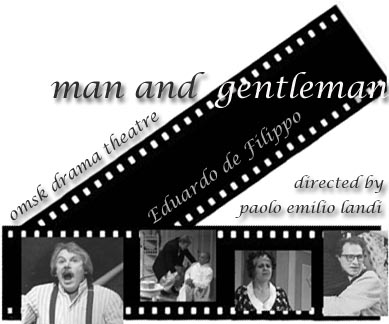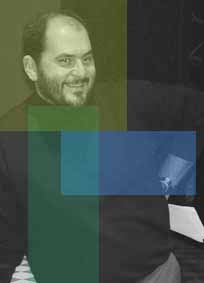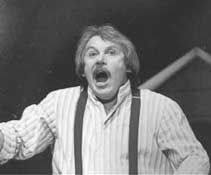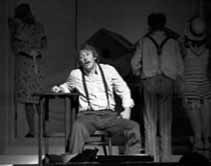![]()

New Russian Translation Available
DIRECTOR'S NOTE
Man and Gentleman belongs to the very early De Filippo's production . Performed the first time in 1922 with another title (Ho fatto il guaio, riparerņ, (I made a mistake, I'll set it right) it is a combination of themes and styles very close to his father's; During all the Twenties, he performed Gennaro in his brother's company (Vincenzo Scarpetta) while his other brother (Peppino De Filippo)* played Alberto. It' is evident the relationship with Misery and Nobility, Scarpetta's best known farce (Eduardo, as all his brothers and sisters played in the role of young Peppiniello). There, two poor families perform the roles of nobles in order to convince a parvenu to give her sole daughter to a young prince, without his family consent. Here a group of actors should perform, and Gennaro has in his hands the destiny of the pregnant Bice. The antinomy is the same: poor against noble, Man against Gentleman.
The mechanism of the farce is not even very polished: the long scene of the rehearsal (a masterpiece of hilarity) could be easily cut without any damage to the plot. It occurs in the first act, while in the third there is a very feeble culmination. Another structural problem of the play is that an important theme, the love story between Gennaro and Viola (so important in the first act), is completely abandoned in the third. We do not even know what happened to her. Finally, Alberto's fake madness is just a farce trick, madness as imagined by a child. M&G is the work of a young playwright, used to copy his father's scripts in the dressing room. But it is also the play of an already long experienced actor. ThIS farce is a laughing-machine, it's a pleasure for the actors to perform.
The Omsk Drama performance was based on the contacts that this farce has with the silent cinema: the first act ends with Salvatore chasing Gennaro and he runs over the boiling pot full of water. The story of the mystery woman. Alberto's fake madness based on gestures more than words. A fairly melodramatic tone. Consequently, the sets, the costumes were in black and white. The action is accompanied by a pianist. The lights and the make up recall the silent cinema. The scenes are introduced by titles projected on a black background. Some melodramatic scenes are subtitled. Between the second and the third act there is even an intermission with a 'live- song'.
On the other hand we emphasized the contrast between Gennaro's hard life and deep human understanding (the man) and the easy destiny of the young Alberto (the gentleman). During his work (the rehearsal) we understand Gennaro's childlike love for theatre and his understanding of human nature. His dream of another life (on stage) where the evil is punished and justice triumphs.
From the point of view of the adaptation we noticed that the third act is clearly less funny of the other two, and leaves open stories important in the first act. During the chasing, end of act one, Viola is about to give birth. She reappears in the third act with the other actors, in the police station, bearing a child. Then arrives his brother, Salvatore (who is really mad) who tries again to chase Gennaro and is finally transferred to the mental hospital. This little insert, although unrealistic but plausible, ( Viola giver birth one day and comes to the police office the next), has produced a more compact third act.

opening night on
Man and Gentleman
Directed by Paolo Emilio Landi
Set & Costumes Santi Migneco
Music by Igor Esipovich
Produced by



